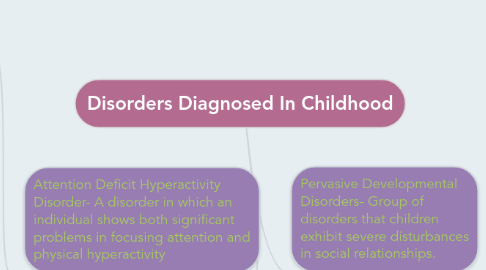
1. Attention Deficit Hyperactivity Disorder- A disorder in which an individual shows both significant problems in focusing attention and physical hyperactivity
1.1. Prevalence And Characteristics of ADHD
1.1.1. 3 to 7% of children have ADHD
1.1.2. Aggressive behavior
1.1.3. Physical restlessness
1.1.4. Problems with attention
1.1.5. Less able than other children of the same age to control impulses.
1.2. Explaining ADHD
1.2.1. ADHD is a neurological disorder
1.2.2. Prenatal environment plays some role in the disorder
1.2.3. A risk factor that is amplified by other kinds of risk factors or balanced by protective factors.
1.2.4. Children who are extremely outgoing are at increases risk of being diagnosed with the disorder
1.2.5. High IQ and intrinsic motivation are protective factors
1.3. Treating ADHD
1.3.1. Successfully treated with amphetamines such as Methylphenidate.
1.3.2. Parent training
1.3.3. amphetamines have positive effects on the behavior of 70 to 90% of children who take them.
2. Pervasive Developmental Disorders- Group of disorders that children exhibit severe disturbances in social relationships.
2.1. Inability to establish & maintain social relationships
2.2. 1% of all children have some kind of PDD
2.3. Autism spectrum disorder
2.4. Autistic Disorder- Children have limited language skills.
2.4.1. Mental Retardation
2.4.2. Easily Distracted
2.4.3. Slow to respond to external stimuli
2.4.4. Highly impulsive
2.5. Asperger's Disorder-A disorder in which children posses the same characteristics as those with autistic disorder but have intact language and cognitive skills.
2.5.1. Characteristics of the disorder start showing between a child's second and third birthday.
2.5.2. Obsessive behavior such as counting and recounting the number of squares on a checkerboard cloth.
2.5.3. Do not develop the capacity to understand others' thoughts, feelings, and motivations
2.5.4. 2 in every 10,000 children in the United States is diagnosed with Asperger's Disorder.
2.6. Treating Pervasive Developmental Disorder
2.6.1. There is no cure for autism
2.6.2. Effective treatment options
2.6.3. Intensive language and social skills training
2.6.4. Behavior modification for self- injurious behaviors
2.7. Explaining Pervasive Developmental Disorders
2.7.1. Disorders are of neurological origin
2.7.2. There are specific genetic defects that lead to Atypical neurological development which causes children to develop PDD.
2.7.3. Hereditary
2.7.4. When mothers are depressed, infants have an increased risk of developing the symptoms of a PDD
